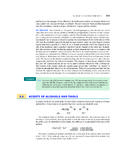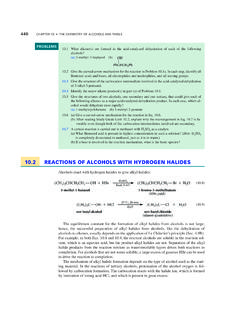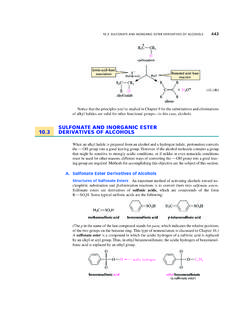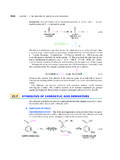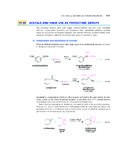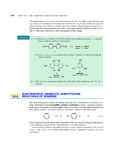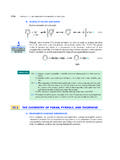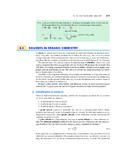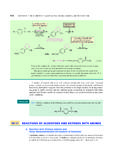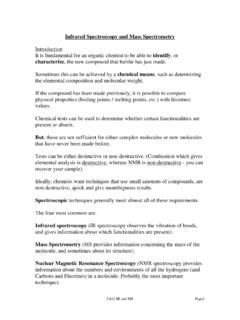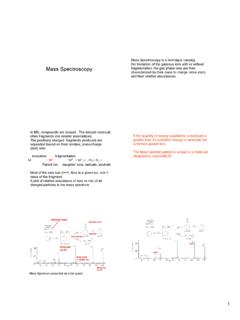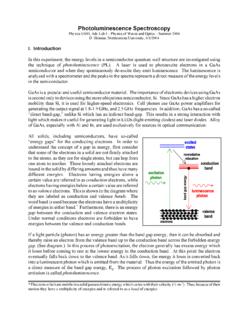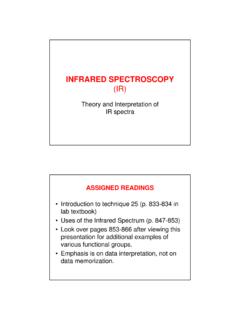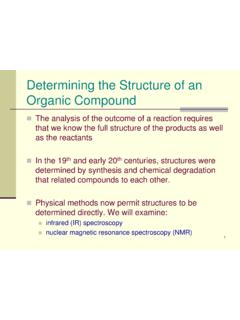Transcription of 19.3 SPECTROSCOPY OF ALDEHYDES AND KETONES
1 SPECTROSCOPY OF ALDEHYDES AND KETONES895 Because of their polarities, ALDEHYDES and KETONES have higher boiling points than alkenes oralkanes with similar molecular masses and shapes. But because ALDEHYDES and KETONES are nothydrogen-bond donors, their boiling points are considerably lower than those of the corre-sponding and KETONES with four or fewer carbons have considerable solubilities in waterbecause they can accept hydrogen bonds from water at the carbonyl and acetone are miscible with water (that is, soluble in all proportions).
2 Thewater solubility of ALDEHYDES and KETONES along a series diminishes rapidly with increasingmolecular and 2-butanone are especially valued as solvents because they dissolve not onlywater but also a wide variety of organic compounds. These solvents have sufficiently low boil-ing points that they can be easily separated from other less volatile compounds. Acetone, witha dielectric constant of 21, is a polar aprotic solvent and is often used as a solvent or co-sol-vent for nucleophilic substitution OF ALDEHYDES AND KETONESA.
3 IR SpectroscopyThe principal infrared absorption of ALDEHYDES and KETONES is the CAO stretching absorption,a strong absorption that occurs in the vicinity of 1700 cm_1. In fact, this is one of the most im-portant of all infrared absorptions. Because the CAO bond is stronger than the CAC bond,the stretching frequency of the CAO bond is DCOS%% D"% Dboiling pointdipole momentboiling pointdipole DOCH3 CHACOS33%%d d+bond dipoleof the C O bondEPM of 12/9/08 11:41 AM Page 895896 CHAPTER 19 THE CHEMISTRY OF ALDEHYDES AND KETONES .
4 CARBONYL-ADDITION REACTIONSThe position of the CAO stretching absorption varies predictably for different types ofcarbonyl compounds. It generally occurs at 1710 1715 cm_1for simple KETONES and at1720 1725 cm_1for simple ALDEHYDES . The carbonyl absorption is clearly evident, forexample, in the IR spectrum of butyraldehyde (Fig. ). The stretching absorption of the car-bonyl hydrogen bond of ALDEHYDES near 2710 cm_1is another characteristic absorption; how-ever, NMR SPECTROSCOPY provides a more reliable way to diagnose the presence of this type ofhydrogen (Sec.)
5 Compounds in which the carbonyl group is conjugated with aromatic rings, double bonds,or triple bonds have lower carbonyl stretching frequencies than unconjugated carbonyl carbon carbon double-bond stretching frequencies are also lower in the conjugated mol-ecules. These effects can be explained by the resonance structures for these compounds. Be-cause the CAO and CAC bonds have some single-bond character, as indicated by the fol-lowing resonance structures, they are somewhat weaker than ordinary double bonds, andtherefore absorb in the IR at lower frequency.
6 ( )compare:COSLLCH3cacetophenone1685 cm_11600 cm_11670 cm_11613 cm_1 COSLLCH3 CHAH2C3-buten-2-oneCHCH2CH3AH2C 1642 cm_11-buteneCOSLLCH2CH3H3C1715 cm_1 2-butanone$$OCA$$$$ 101112 13 14 15163400 3000 2600 2200 2000 1800 1600wavenumber, cm_1wavelength, micrometers1400 1200 1000800600percent transmittanceCH3CH2CH2 CHOCO stretchCOHstretchFigure infrared spectrum of butyraldehyde with key absorptions indicated in 12/9/08 11:41 AM Page SPECTROSCOPY OF ALDEHYDES AND KETONES897In cyclic KETONES with rings containing fewer than six carbons, the carbonyl absorption fre-quency increases significantly as the ring size decreases.
7 (See Further Exploration )B. Proton NMR SpectroscopyThe characteristic NMR absorption common to both ALDEHYDES and KETONES is that of the pro-tons on the carbons adjacentto the carbonyl group: the a-protons. This absorption is in region of the spectrum (see also Fig. on p. 580). This absorption is slightly far-ther downfield than the absorptions of allylic protons because the CAO group is more elec-tronegative than the CAC group. In addition, the absorption of the aldehydic proton is quitedistinctive, occurring in the d9 10 region of the NMR spectrum, at lower field than most otherNMR general, aldehydic protons have very large chemical shifts.
8 The explanation is the same asthat for the large chemical shifts of protons on a carbon carbon double bond (Sec. ).However, the carbonyl group has a greater effect on chemical shift than a carbon carbon dou-ble bond because of the electronegativity of the carbonyl Explain how IR spectra could be used to differentiate the isomers within each of thefollowing pairs.(a)cyclohexanone and hexanal (b) 3-cyclohexenone and 2-cyclohexenone(c)2-butanone and 3-buten-2-olPROBLEM( )OScyclohexanone1715 cm_1(normal)OScyclopentanone1745 cm_1 SVOcyclobutanone1780 cm_1 OScyclopropanone1850 cm_1 CAOAH2 Cketene2150 cm_1( )single-bondcharacterCLLCH3 CHAH2 COS33 CLLCH3 CHAH2C|O_"332 Further Exploration Absorptions ofCyclic 12/9/08 11:41 AM Page 897898 CHAPTER 19 THE CHEMISTRY OF ALDEHYDES AND KETONES .
9 CARBONYL-ADDITION REACTIONSC. Carbon NMR SpectroscopyThe most characteristic absorption of ALDEHYDES and KETONES in 13C NMR SPECTROSCOPY is thatof the carbonyl carbon, which occurs typically in the d190 220 range (see Fig. , p. 624).This large downfield shift is due to the induced electron circulation in the pbond, as in alkenes(Fig. , p. 613), and to the additional chemical-shift effect of the electronegative carbonyloxygen. Because the carbonyl carbon of a ketone bears no hydrogens, its 13C NMR absorp-tion, like that of other quaternary carbons, is characteristically rather weak (Sec.)
10 Thiseffect is evident in the 13C NMR spectrum of propiophenone (Fig. ).The a-carbon absorptions of ALDEHYDES and KETONES show modest downfield shifts,typically in the d30 50 range, with, as usual, greater shifts for more branched carbons. Thea-carbon shift of propiophenone, ppm (Fig. , carbon b) is typical. Because shifts inthis range are also observed for other functional groups, these absorptions are less useful thanthe carbonyl carbon resonances for identifying ALDEHYDES and Deduce the structures of the following compounds.
